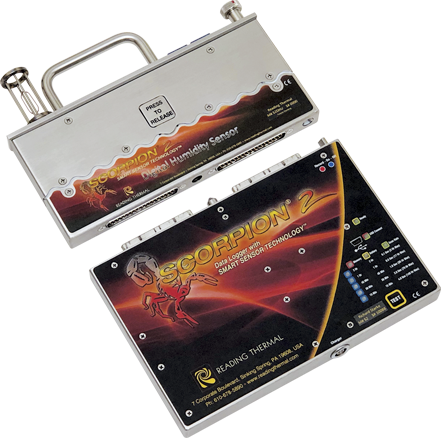Water vapor, or humidity, in industrial bakery oven systems affects baking times and alters the texture and outcome of your finished products. The Scorpion® 2 Profiling System from Reading Thermal gives you the power to ensure that the conditions in your oven are well-suited to your processing needs and shelf-life requirements.
Reading Thermal, a Reading Bakery Systems brand, has researched the commercial baking process for more than 25 years. Our team of heat transfer experts developed the SCORPION® 2 Profiling System and Data Logger, now an industry standard that measures and maps essential baking parameters, such as temperature and humidity, that affect the quality of your products.
Why Humidity Profiling is Important?
Products passing through a thermal process interact with the amount of moisture in the environment. Much of this moisture comes from the products themselves and represents a delicate balance that can affect finished products in many ways. For example:
- High oven humidity can increase the volume of your baked goods.
- High oven humidity can lighten the crust color of baked goods.
- High oven humidity can soften crisp crusts and make crackers lose their crunch.
- Too little humidity in a cracker oven can cause excessive blisters to develop, which burn easily, causing undesirable dark spots.
- Too little moisture in a finished product can directly affect breakage during the packaging process.
- Too little moisture can cause goods that should be soft and moist to overbake and become tough or dry.
- The amount of moisture left in a pretzel after baking affects its shelf life.
- Reducing evaporation can keep the surface of a cookie moist, allowing it to stretch and preventing cracks.
Using quality ingredients and careful handling throughout the various stages of production are not enough to create a quality product unless the temperature and humidity of the oven are carefully monitored and regulated.
Measuring Oven Humidity
Bakeries all over the world rely on the SCORPION® 2 Humidity Sensor to measure the absolute moisture content of the thermal environment in both heating and cooling processes. The sensor travels through the oven with the product, yielding a precise profile of moisture it experiences.
Mechanically, the humidity sensor has a high temperature moisture sensor, a low temperature moisture sensor, and a bulk air or dry bulb temperature sensor. In ovens, the humidity sensor can be used to document the relationship between oven moisture and finished product moisture. In Cooling Tunnels, it can be used to monitor dew point temperature to prevent condensation on the product surface.
Are you experiencing inconsistent product quality, moisture retention, uneven bakes, or low production capacity? Don’t just place your dough in the oven and hope for the best. The SCORPION® 2 Profiling System and Data Logger from Reading Thermal will help you bake your products to perfection. Contact us online, or call us at (610) 678-5890 Ext. 2 for more details about our innovative products.

